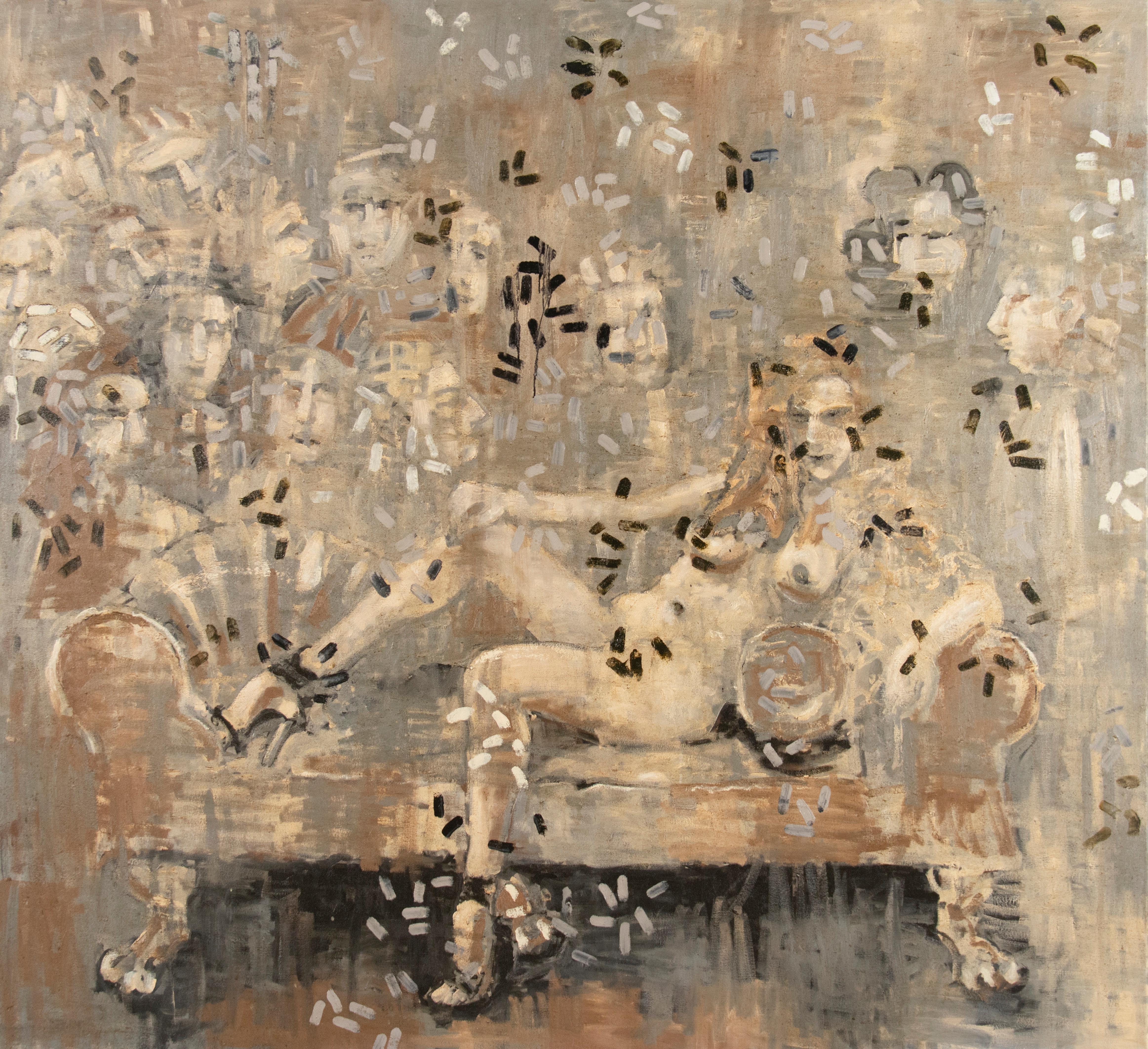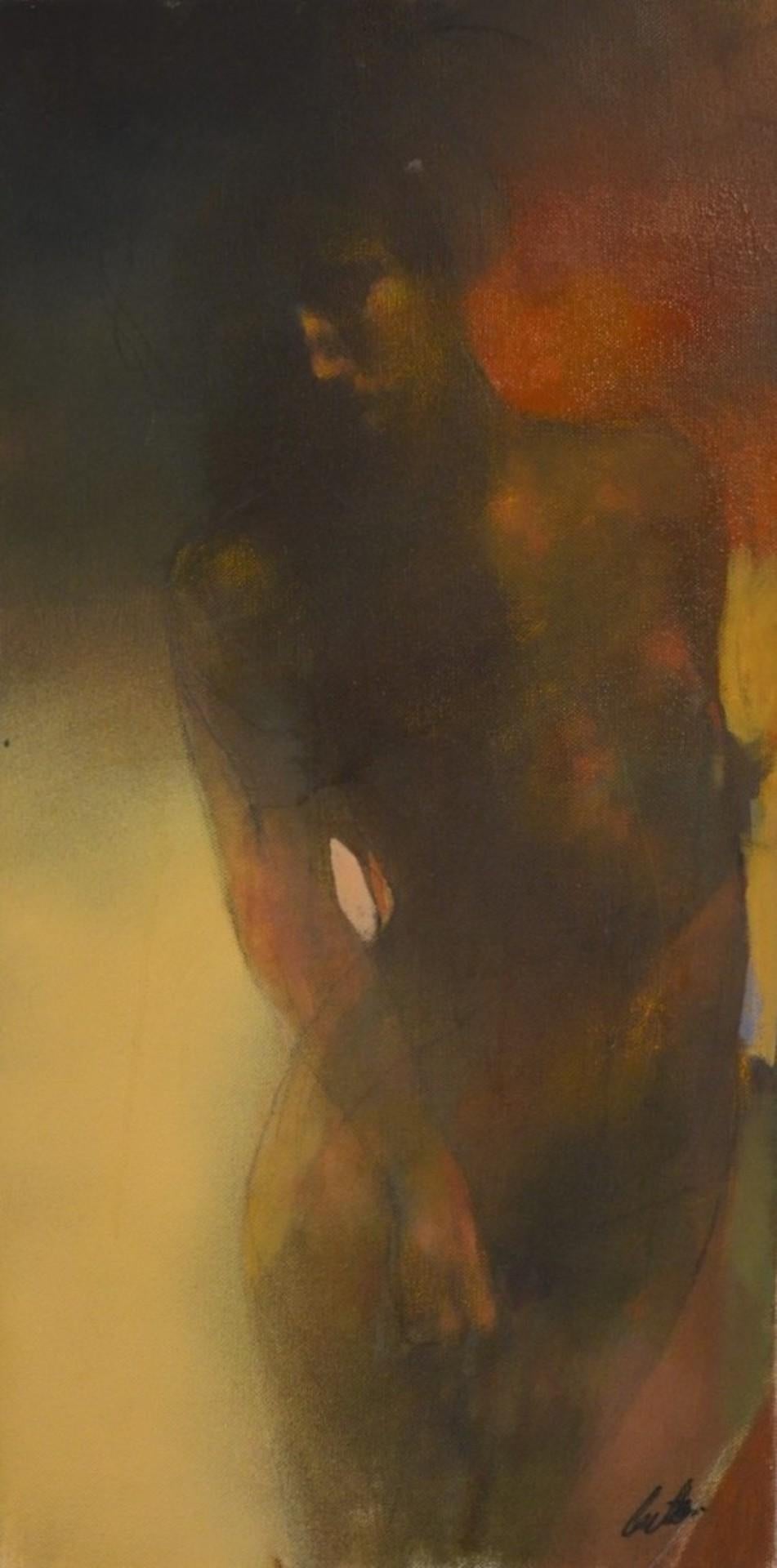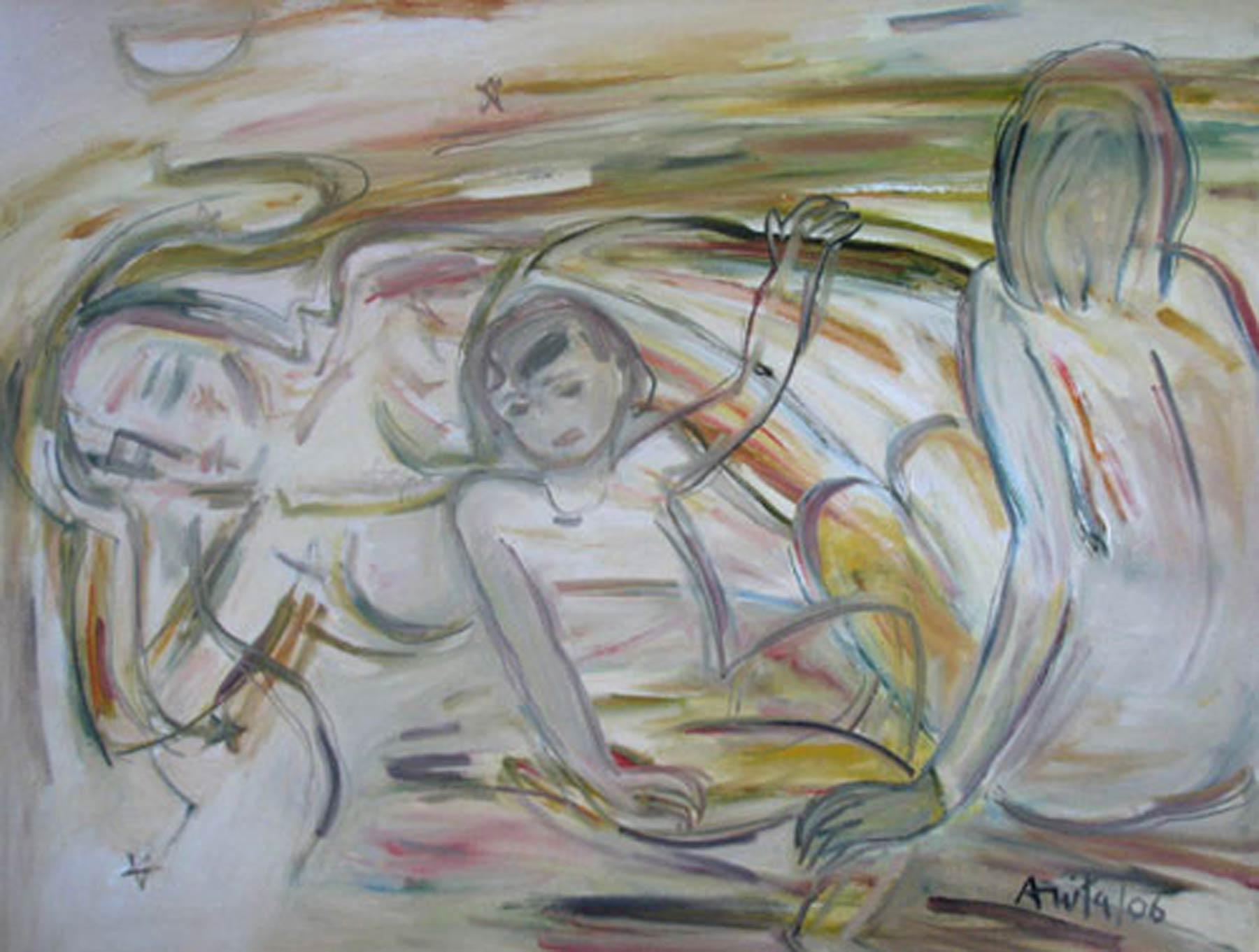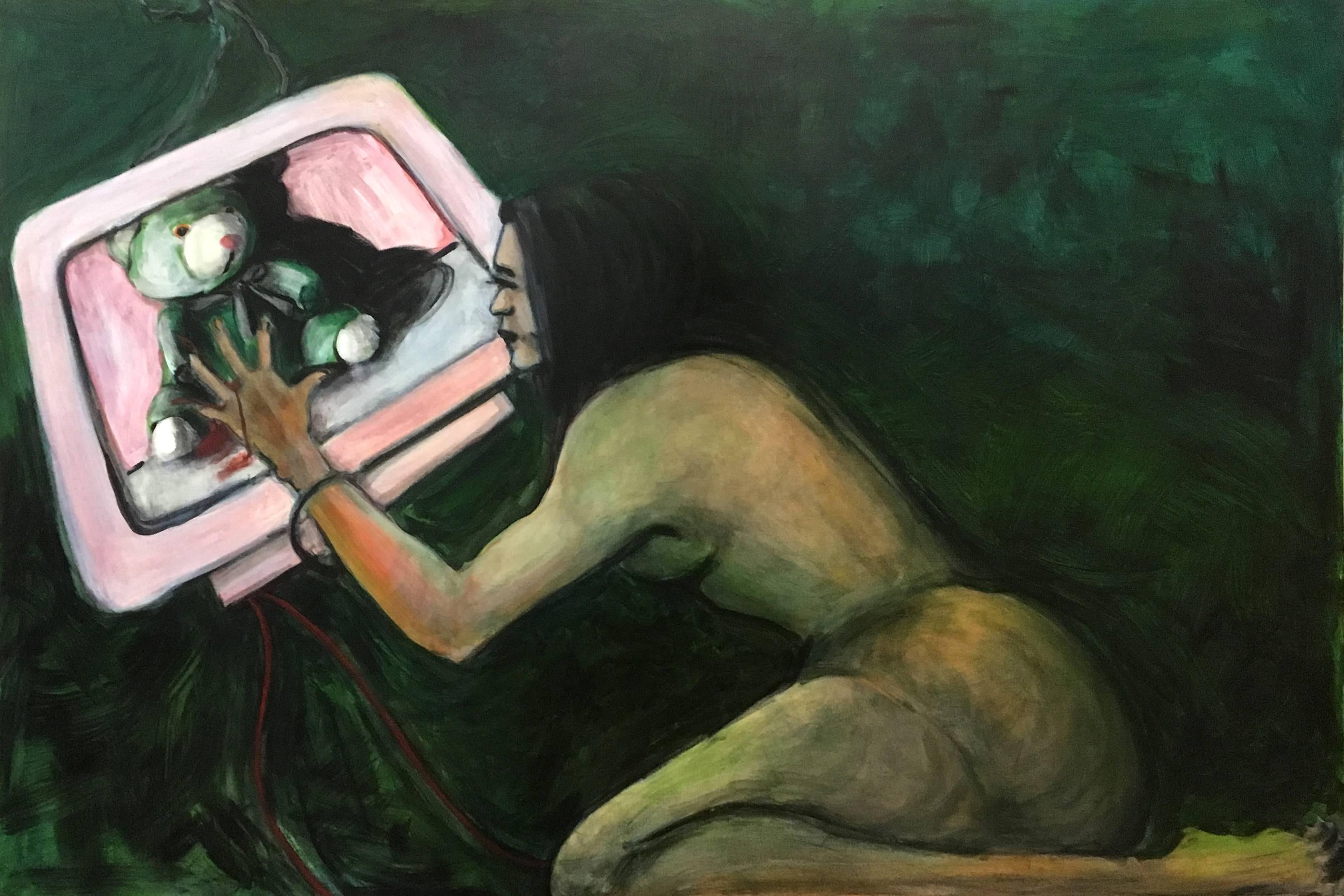Items Similar to Nudes
Video Loading
Want more images or videos?
Request additional images or videos from the seller
1 of 11
Salcia BahncNudes
About the Item
Nudes
By. Salcia Bahnc (Polish, American, 1898-1976)
Signed Lower Middle
Unframed: 14 x 18 inches
Framed: 23 x 26 inches
Painter, illustrator, printmaker, teacher. Born in Dukla, Poland. Though she was born in Dukla, a town in south-eastern Poland, she moved to Prsemysl, one of the largest and most ancient cities of southern Poland, at a young age. Her mother was reportedly descended from the "Van Ast" family, a Dutch dynasty that produced several artists, including Balthasar van der Ast (1593/4 - 1657). According to one art historian she came to New York at the age of five (c. 1903), and another, at the age of eight (c. 1906).
Her family was Jewish and reportedly quite wealthy. Why they would have left imperial Austria, under whose sovereignty either of her proposed birth cities were under, is unknown. However, while these areas did not suffer the pogroms typical in neighboring imperial Russia, the Austro-Hungarian empire had become much more anti-Semetic, which may have hasten there departure. How, according to one source, they ended up living in the Jewish ghetto of New York is extremely puzzling. Did they loose their wealth to some business disaster? Where they forced to leave it behind? Was there some familial tragedy? We may never know.
In her youth she lived first in New York City and then in Boston, Massachusetts, where her family had relatives. It is reported that when she was in fourth grade she was found to be so competent in drawing that for the next two years she taught a drawing class after school for the other children. In Boston, Bahnc's mother eventually remarried and moved the family to Chicago where the young artist was primarily raised.
In Chicago she worked during the days as a sales clerk in a department store. At night she put herself through school at the School of the Art Institute of Chicago (SAIC) and taught at her former alma mater after her graduation during the years 1923-1929. She also studied at the Chicago Academy of Fine Art. She took up design work and began exhibiting painted silk creations at a private Chicago gallery (probably Thurber, see below). The first museum exhibitions she is known to have participated in were held at the Art Institute of Chicago. During this period she became known for her portraits.
Originally a resident alien, she was naturalized at the district court of Chicago, Illinois in July of 1913. In 1920 she lived on East Ontario Street in Chicago in a neighborhood filled with art studios and artists, including James Allen Saint-John (1872-1957), Paul Bartlett (1881-1965), Pauline Palmer (1867-1938), and George Ames Aldrich (1872-1941). It is in Chicago that she saw her greatest success as an artist. In 1927, Chicago art dealer Chester H. Johnson said of her work: "The Art of Salcia Bahnc is a sincere manifestation of the spirit we know as 'Modernism' . . . . . . She is the spirit of the Age, not its Fashion." Local reviewers agreed, one going as far to say that her exhibition was " . . . the most interesting one man show by a young artist that has ever been presented to Chicago, and I keep telling myself that New York will get her if we don't watch out."
She was apparently a favorite and friend of art critic Clarence Joseph Bulliet (1883-1952), who authored a number of books and articles that praised Bahnc's work. Bulliet was central in introducing and popularizing modern art in the mid-western United States. In his book Apples and Madonnas: Emotional Expression in Modern Art (1935) he called Bahnc a "A thorough Expressionist." A year later in his book The Significant Moderns and Their Pictures (1936) he noted that one of her paintings of a nude was ". . . powerful in its elemental brutality."
During this period other critics reported positively on the work she was producing. Ida Ethelwyn Wing reported in a volume of the Delphian Text (1930) that Bahnc, was without doubt, ". . . the most vigorous and intensively original of the American Expressionists." Paul Masserman and Maxwell Baker said of her in their work The Jews come to America (1932) that she was part of a group of artists that were "Chief among modern Jewish painters. . . "
Salcia Bahnc traveled back and forth to Europe during the late 1920s and into the 1930s, a period when she faced the rise of totalitarianism. She wrote about this fact to a fellow artist to whom she commented " . . . about the difficult art scene in Paris . . . . . . and the growing power of fascism." In 1930 she was maintaining a studio in New York City at 1218 East 53rd Street and a residence in Brooklyn, Long Island. She returned to France where she married a French citizen and writer named Eugene Petit (b. 1901) and bore a son there named Alain Petit (b. 1934). She again returned to the United States in November of 1937 and traveled back to France after a brief stay in America. During her stay she continued to exhibit in Chicago, where Quest Galleries gave her a solo show.
Like so many ex-patriot authors and artists who were living in Paris, she found herself trapped in France (first in Paris, then in Mayenne) following the German invasion in 1940. Being of Jewish extraction the situation could prove to be quite dangerous if she were reported or discovered by German authorities. She and her husband were able to obtain passports and escape to Portugal where in August of 1941 they boarded the S. S. Escambion to return to America.
In 1940, American Export Lines, owners of the Escambion, discontinued its normal Mediterranean routes and placed their ships into service sailing from Lisbon, Portugal to New York City. Over the next two years (1940 - 1941) their ships played an important role in transporting thousands of people who were trying to escape the Nazi regime before America's own entry into World War II. One survivor, Ludwig Lowenberg, who sailed on the Escambion on the same day that Bahnc did, reported the ordeal his family endured getting to Lisbon to his own descendants:
"[The family] received their American visa on May 28, 1941, only three days before the U.S. consulate in Stuttgart closed for the duration of World War II. They left Berlin on June 23, 1941, traveling for 27 hours on a locked train to Paris. There they were forced to spend an additional night in the locked train until their coach was attached to a train headed for San Sebastian in Spain. After an overnight hotel stay in San Sebastian, the train (now no longer locked) continued to Lisbon. All in all it took six days from Berlin to Lisbon. They remained for four weeks in Lisbon until they embarked on the Excambion for New York."
Bahnc had given up her citizenship during her time in France and was forced to reapply for naturalization once again upon her return. She was living in New York City at 101 West 85th Street when she was re-naturalized in April of 1947.
Exactly how much of her artwork was lost in Europe is not known. Clearly, she would not have been able to bring much, if anything, with her during her escape. One writer had noted that between 1930 and 1934 she had worked hard to prepare a large group of new works for a show in Paris. Between those, and what she would have produced during the next six years, the actual amount of the loss might have been staggering. Bahnc's 1942 exhibition with Julio de Diego included works recalling the suffering going on in Europe. One work in the exhibition was a portrait of the painter Katherine Dudley, who, at the time, was reportedly interned near Paris.
In the later years of her career she worked extensively as a teacher and illustrator of children's books. In 1950 she taught at the Evanston Art Center, where she lead a demonstration in portrait painting. She authored or illustrated a number of works during and after World War II, including: The House in the Tree and Other Stories of Places, People and Things (1941); Claude Of France: The Story Of Debussy For Young People (1948); Time for Poetry (1951); Hidden Silver (1952); From Many Lands - The Children's Hour, Volume 9 (1969); and That Boy (no date). She returned to teach at the School of the Art Institute of Chicago during 1943-44 and 1947-53; and taught later at the Garrison Forest School in Garrison, Maryland, from 1955-57.
Bahnc was known to have exhibited widely, both in Europe and in America. Her known lifetime exhibitions include: The Art Institute of Chicago, Chicago, IL, 1919-29, 1942 (The 53rd Annual; and Room of Chicago Art: Exhibition of Paintings by Salcia Bahnc and Julio de Diego), 1943; Chicago Architectural Sketch Club, Chicago, IL, 1921; Whitney Museum of American Art, New York, NY, 1922 (prize), 1923 (prize); Pennsylvania Academy of Fine Art, Philadelphia, PA, 1925; Chester H. Johnson Galleries, Chicago, IL, 1925, 1927 (solo), 1929, 1930 (solo), 1931 (solo); Architectural League, Chicago, IL, 1925; Marie Sterner Gallery, New York, NY, 1928; Society of Independent Artists, New York, NY, 1928; Women's World Fair Exhibition, Chicago, IL, 1928; Sur.-Independents, Paris, France, 1929; Brooklyn Museum of Art, Brooklyn, NY, 1932; Gallerie La Jeune Peinture, Paris, France, 1934 (solo); Salon des Tuileries, Paris, France, 1930-1935; Annual Exhibition of Works by Chicago and Vicinity Artists Exhibition, Chicago, IL, 1935 (prize), 1942 (held at AIC, prize); Findlay Galleries, Chicago, IL, 1935, 1950; Quest Galleries, Chicago, IL, 1938 (solo); Albert Roullier Galleries, Chicago, IL, 1943 (solo); Bahnc Studio Exhibition, Chicago, IL, 1949 (solo); Louise and Thurman Nicholson Gallery, Chicago, IL, 1950 (retrospective); Art Gallery of the College of Jewish Studies, Chicago, Il, 1950 (solo); Thurber Art Galleries, Chicago, IL, c. 1920s.
Salcia Bahnc Petit died in the borough of the Bronx, New York, on Tuesday, the 1st of May 1979. She was 87 years old.
Since her death, Bahnc's works have been included in more recent museum exhibitions, including "The Emergence of Modernism in Illinois 1914-1940," held at the Illinois State Museum, Springfield, IL, 1976; and "New Woman in Chicago, 1910-45: Paintings from Illinois Collections," held at Rockford College and Illinois State Museum, Springfield, IL, 1993-94.
Her works are held in a number of private collections and by the following institutions: Illinois State Museum, Springfield, IL; Princeton Art Museum, Princeton, NJ; The Arts Club of Chicago, Chicago, IL; and The Art Institute of Chicago, Chicago, IL.
- Creator:Salcia Bahnc (1896 - 1979, Polish, American)
- Dimensions:Height: 14 in (35.56 cm)Width: 18 in (45.72 cm)
- Medium:
- Movement & Style:
- Period:
- Condition:
- Gallery Location:Missouri, MO
- Reference Number:1stDibs: LU747312419122
About the Seller
5.0
Vetted Seller
These experienced sellers undergo a comprehensive evaluation by our team of in-house experts.
Established in 1970
1stDibs seller since 2017
142 sales on 1stDibs
Typical response time: 21 hours
- ShippingRetrieving quote...Ships From: Missouri, MO
- Return PolicyA return for this item may be initiated within 2 days of delivery.
More From This SellerView All
- A Conundrum in the KitchenBy Frank HydeLocated in Missouri, MOFrank Hyde (British 1849-1937) "A Conundrum in the Kitchen" c. 1900 Oil on Canvas Signed Lower Left Image: 37.5 x 57.5 inches Framed: 44 x 64.5 inches From the Maidstone Museum, UK: Hyde was born in Surrey in 1849 and spent a large amount of time in London during his youth. His father had been in the army but retired to live the life of a gentleman upon inheriting the family seat, Hyde End Manor in Berkshire. Hyde, however, would later inherit and sell the Manor. As a young man, Hyde trained as an artist at the Royal Academy, London, and his subsequent career revealed striking artistic versatility. His subjects varied from the portrayal of real, dramatic events to comic characters commissioned by the card manufacturer Raphael Tuck. Starting out as a 1st Lieutenant in the Royal Engineers, Hyde moved on to begin his career as a war artist during the Franco-Prussian war of 1870-71, producing drawings for ‘The Graphic’, an illustrated weekly publication. Hyde married Constance Mary Louise Felgate in 1876, but she died less than a year later. While he travelled extensively throughout his life after Constance’s, death Hyde purchased a villa in Capri where he met Rosina Ferrara, whom he used as a model, and John Singer Sargent, with whom he shared a studio. Hyde is perhaps best known for his paintings of Capri...Category
1890s Realist Figurative Paintings
MaterialsCanvas, Oil
- Poor Man's FlockBy George Chambers 1Located in Missouri, MOGeorge W. Chambers “Poor Man’s Flock” 1897 Oil on Canvas 23.5 x 37.5 inches/42 x 57 inches framed approx. In Original Frame Provenance: The Artist thence by Descent; to Private Mi...Category
1890s Victorian Figurative Paintings
MaterialsCanvas, Oil
- The First ShipBy Thomas MoranLocated in Missouri, MO*See VIDEO included in pictures. Can send additional if requested. approx. 19 x 25 inches framed. *This work is included in The Thomas Moran Catalogue Raisonne Project (See Steve G...Category
1860s American Realist Landscape Paintings
MaterialsOil, Canvas
- Mad RiverBy Julio LarrazLocated in Missouri, MOMad River, 1996 Julio Larraz (Cuban, 1944) Signed and Dated Lower Right 41 x 49 inches 43 x 51 inches with frame Provenance: Atrium Gallery, 1999 Accomplished painter, sculptor, and...Category
1990s Contemporary Figurative Paintings
MaterialsOil, Canvas
- La Peche a la LigneBy Henri Gabriel IbelsLocated in Missouri, MOLa Peche a la Ligne Henry-Gabriel Ibels (French, 1867-1936) Signed Lower Left 25.75 x 20 inches 35 x 29 inches Henri-Gabriel Ibels (30 November 1867 Paris – February 1936 Paris), wa...Category
Early 20th Century Impressionist Figurative Paintings
MaterialsOil, Canvas
- The AndalusiaBy John Frederick Herring Sr.Located in Missouri, MOThe Andalusia John Frederick Herring (English, 1795-1865) Signed Lower Right 14 x 18 inches 18 x 22 inches with frame Provenance: Frost &Reed, Ltd., London 1984 Herring, born in London in 1795, was the son of a London merchant of Dutch parentage, who had been born overseas in America. The first eighteen years of Herring's life were spent in London, where his greatest interests were drawing and horses.[2] In the year 1814, at the age of 18, he moved to Doncaster in the north of England, arriving in time to witness the Duke of Hamilton's "William" win the St. Leger Stakes horserace. By 1815, Herring had married Ann Harris; his sons John Frederick Herring Jr., Charles Herring, and Benjamin Herring were all to become artists, while his two daughters, Ann and Emma, both married painters. When she was barely of age in 1845 Ann married Harrison Weir. In Doncaster, England, Herring was employed as a painter of inn...Category
Mid-19th Century English School Animal Paintings
MaterialsOil, Canvas
You May Also Like
- Seated NudeBy Helge HelmeLocated in New York, NYAxel Henry Helge Helme (1894 Roskilde, Denmark 1987), Seated Nude, circa 1930, oil on canvas, original frame Son of a merchant, Helge Helme was admitted ...Category
20th Century Expressionist Nude Paintings
MaterialsOil, Canvas
- Two ladies with glassesLocated in Wien, 9Gurami Hagemann was born in Tiblissi in Georgia in 1945. At the age of 15 he received his diploma in painting. From 1965 to 1971 he attended the Art Academy in Tiblissi. In 1993 he r...Category
20th Century Expressionist Nude Paintings
MaterialsCanvas, Oil
- Paul Manes - Suzanna...Later, Paintings 2020By Paul ManesLocated in Greenwich, CTPaul Manes was born May 4, 1948, in Austin, Texas. He began his professional career in New York City in the early 1980s. His art has been widely exhibited in America and Europe and h...Category
2010s Expressionist Nude Paintings
MaterialsCanvas, Paint, Oil
- Emerging, Bill Bate, Original Figurative Painting, Nude Portraiture, AffordableBy Bill BateLocated in Deddington, GBBill Bate Emerging Original Figurative Painting Oil Paint on Canvas Canvas Size: H 60cm x W 30cm x D 2cm Sold Unframed Please note that in situ images are purely an indication of how...Category
21st Century and Contemporary Expressionist Nude Paintings
MaterialsCanvas, Oil
- Mother & Child, Nude Oil paint, Earth Colours by Indian Modern Artist "In Stock"By Anita Roy ChowdhuryLocated in Kolkata, West BengalAnita Roy Chowdhury - Mother & Child - 36 x 48 inches ( unframed size) Oil on canvas Inclusive of shipped in roll form. Style : Her works manifest human figures, nude or draped in d...Category
Early 2000s Expressionist Figurative Paintings
MaterialsOil, Canvas
- UntitledBy Jackie FelixLocated in Buffalo, NYAn original expressionist painting by American female artist Jackie Felix.Category
1980s Expressionist Nude Paintings
MaterialsCanvas, Oil




